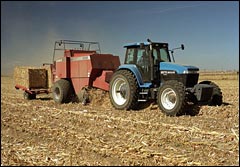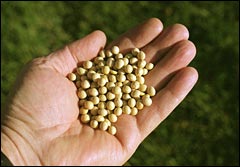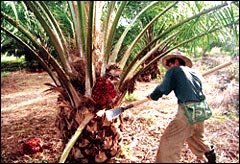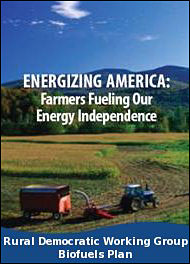
Nothing but blue skies from now on?
Photo: house.gov
Great news! We can finally scratch “driving less” off our list of ways to curb global warming and reduce our dependence on foreign oil! Biofuels will soon not only replace much of our petroleum, but improve soil fertility and save the American farmer as well!
Sound too good to be true? Well, yes. But you could be excused for buying the hype.
Ethanol and biodiesel are being promoted as cures for our energy and environmental woes not just by flacks for corporations like Archer Daniels Midland, BP, and DuPont, but by many eco-minded activists and some prominent environmental groups like the Natural Resources Defense Council as well.
As intuitive as it may seem that fuel from plants would be more benign than petroleum-based fuels, the ecological impacts of biofuel production are more complicated, and wider-reaching, than an environmentalist might first imagine.
For years, some critics have claimed that corn-based ethanol has a negative “net energy balance” — that is, that ethanol requires more energy to produce than it delivers as fuel. But as biofuel production efficiencies have improved, critics have turned their focus to broader sustainability issues.
“Even if corn and soy biodiesel have positive energy balances, that’s not enough,” says Andy Heggenstaller, a graduate student at Iowa State University researching biofuel crop production. “Large-scale production of corn and soybeans has negative ecological consequences. If biofuels are based on systems that exacerbate soil erosion and water contamination, they’re ultimately not sustainable.”
Stalk in Trade
Corn is one of the planet’s most energy-intensive crops. Industrial corn production requires huge quantities of synthetic nitrogen fertilizers (derived primarily from natural gas) and petroleum-based pesticides like atrazine, a known endocrine disrupter. Soybeans need less nitrogen, but farmers douse bean fields with other nutrients and with chemicals like Roundup to keep them pest-free.

You can’t make a biofuel omelet without breaking ags.
Photo: nrel.gov
The effects of corn and soybean production in the Midwest include massive topsoil erosion, pollution of surface and groundwater with pesticides, and fertilizer runoff that travels down the Mississippi River to deplete oxygen from a portion of the Gulf of Mexico called the dead zone that has, in the last few years, been the size of New Jersey.
As ethanol use pushes corn prices higher, farmers are increasingly abandoning the traditional corn-soybean rotation to what’s known in farm country as corn-on-corn. High prices have encouraged farmers to plant corn year after year, an intensification that boosts fertilizer and pesticide requirements.
Water use has also become a concern as corn production expands into drier areas like Kansas, where the crop requires irrigation. The ethanol boom has sent water demands skyrocketing, putting pressure on already suffering sources like the Ogallala aquifer.
And according to a recent report by the World Resources Institute, stepped-up corn ethanol production means not only increases in soil erosion and water pollution, but increases in greenhouse-gas emissions. “If your objective is reducing greenhouse-gas emissions, you need to be aware of what’s happening in the agricultural sector,” says Liz Marshall, coauthor of the WRI study.
Ethanol proponents say the fuel emits up to 13 percent fewer greenhouse gases than gasoline. But an increase in emissions on the farm could cancel out benefits from emission decreases at the tailpipe.
A Kinder, Gentler Crop?
These environmental concerns have led researchers like Heggenstaller to join a wave of interest in a new generation of biofuels, the much-hyped but yet-to-be-seen-on-the-market cellulosic ethanol. Cellulosic differs from grain ethanol in that the fuel comes from the fiber in the plant, rather than the starches in the grain. Any type of plant material can be a source of cellulose, and even cow manure could be processed into fuel.
Fans of cellulosic ethanol are interested in perennial grasses like prairie native switchgrass and towering miscanthus, which require much lower quantities of fertilizers and pesticides than corn and eliminate the need to plow fields annually, a major cause of soil erosion. They say these crops could produce much greater quantities of biomass than corn, and on lands less suitable for crop production.
Indeed, if biofuels are going to make a substantial dent in meeting our fuel needs, processors will need to look beyond corn. If all the corn currently grown in the U.S. were turned into ethanol, it would replace only 15 percent of our annual gasoline demand. (By way of comparison, we could eliminate 15 percent of our gasoline demand by increasing average fuel efficiency of U.S. cars by just four miles per gallon — an attainable goal using on-the-shelf technology.)

Soy has problems of its own.
Photo: nrel.gov
Due to soybeans’ relatively low oil yield, soy biodiesel production in the U.S. has already been written off as marginal by most researchers. So many academic and industry leaders are intensely optimistic about the transition to cellulosic sources.
“There’s no doubt cellulosic ethanol can supply our energy needs,” says Emily Heaton, manager of Energy Crop Product Development at Ceres, Inc., a California-based plant biotechnology company that’s working to develop high-yield biomass crops. She agrees with projections from the U.S. Department of Energy that say fuel from perennial grasses could replace more than a third of our petroleum needs by 2030. “We’ll be producing more than a billion tons of biomass a year in an environmentally sustainable way,” Heaton says.
But even the advent of cellulosic ethanol — which is not expected to come on line for at least several more years — could mean more corn, according to Charles Brummer, a professor of plant breeding at the University of Georgia who works with switchgrass and other perennial biomass plants. Corn stalks and other residues from the corn harvest could be used to make cellulosic ethanol just as readily as switchgrass.
“Farmers will produce what makes money,” Brummer says. “As long as farm programs support corn production, we’re not going to see them growing much of anything else.”
Meanwhile, in the Rest of the World
The hype over biofuels in the U.S. and Europe has had wide-ranging effects perhaps not envisioned by the environmental advocates who promote their use. Throughout tropical countries like Indonesia, Malaysia, Brazil, and Colombia, rainforests and grasslands are being cleared for soybean and oil-palm plantations to make biodiesel, a product that is then marketed halfway across the world as a “green” fuel.

Socking it to an African palm in Myanmar.
Photo: myanmar.gov.mm
In Southeast Asia, and increasingly in the Amazon, plantations of the African oil palm have become wildly lucrative. After monocropping the palms on recently cleared rainforest land, growers press the palm fruit and kernel for oil that can be used in both food and industrial applications, including — and increasingly — as biodiesel.
The palm oil industry is booming: global exports increased more than 50 percent from 1999 to 2004. To meet the growing demand, producers in Malaysia and Indonesia have ramped up production by clearing thousands of square miles of rainforest for new plantations.
In Indonesia, rainforest loss for oil palms has contributed to the endangerment of 140 species of land animals, while in Malaysia animals like the Sumatran tiger and Bornean orangutan have been pushed to the brink of extinction. Fish kills have become common in waterways surrounding plantations and palm-oil mills, as soil erosion from the cleared land and mill effluents have left waterways clogged with sediment and unviable.
The boom hasn’t been limited to Southeast Asia. In one of the most disturbing examples of the biofuel hype’s hidden effects, right-wing paramilitary groups in Colombia — a country mired in a four-decade-old civil war — have in recent years begun planting oil palm plantations over wide swaths of the territory they control. These areas of tropical forest, which lie in the northwestern coastal region known as the Chocó and rank among the planet’s key storehouses of biodiversity, have been almost entirely expropriated through violence, including massacres of Afro-Colombian and indigenous communities that have forced those populations out of the region.
Farther south, another biodiversity hotspot is being rapidly cleared to plant a biodiesel crop. Nearly 80 percent of Brazil’s Cerrado region — a woodland savanna mix — has been cleared for agricultural production, mostly for soybeans, according to a Conservation International report.
Despite being home to thousands of endemic plant and animal species, the Cerrado has been promoted as “the last agricultural frontier” by green-revolution hero and Nobel Peace Prize winner Norman Borlaug. Low land and labor costs and high yield potential have sent investors from as far away as Iowa scrambling to buy up these Brazilian grasslands, frequently in collaboration with U.S. agribusinesses like Archer Daniels Midland, whose first Brazilian biodiesel production facility is currently in the works.
Tad Patzek, a professor in UC-Berkeley’s Department of Civil and Environmental Engineering who’s known primarily as a critic of corn ethanol, says what’s happening in tropical ecosystems is much more serious than the biofuel situation in the U.S. “We’ve already destroyed the prairie, and the topsoil in the Midwest is going, going, gone,” Patzek says. “But the expensive noise we’re making here is being translated there into the total obliteration of the most precious ecosystems on earth.”


